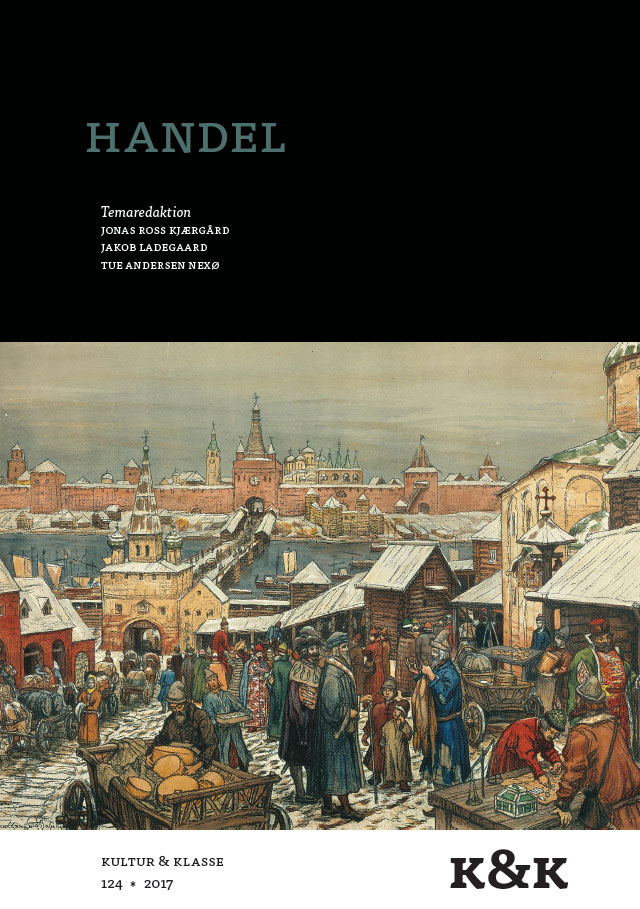”Jeg er købmand og ikke filosof”: Sex, handel og venskab mellem kristne og muslimer i Boccaccios Decameron
DOI:
https://doi.org/10.7146/kok.v45i124.103796Keywords:
Decameron, handel, muslimer, geografi, kønAbstract
This article investigates the function of trade in the representation of Muslims and Islamic culture in Giovanni Boccaccio’s Decameron (1348-52). It is argued that trade establishes friendly contacts across religious and cultural differences, that the image of Muslims is less condemning than is case of Boccaccio’s contemporaries Dante and Petrarch, and that the Oriental world is represented as a place in which the Christians become rich and successful. Sometimes the Muslim world is indirectly represented as a place from which a critical view of Europe can be thrown. The article analyses two stories in particular: the second day’s seventh story about Saracen princess Alatiel who, despite having had sex ten thousand times with eight lovers, successfully presents herself to the King of the Algarve as his virgin bride, and the seventh day’s ninth story about Zinevra who escapes from her revengeful husband and travels to Aleksandria disguised as a male merchant. In different ways the stories merge sexual and trade logic. Boccaccio’s stories are not considered as realistic sources to get knowledge about the medieval world, but the article argues that geographical references to medieval trade centres and routes show that the stories are influenced by the merchant culture thematically and structurally.
References
Abulafia, David. ”The Role of Trade in Muslim-Christian Contacts during the Middle Ages”. The Arab Influence in Medieval Europe. Red. Dionisius Agius og Richard Hitchcock. Reading: Ithaca Press, 1994: 1-24.
Alighieri, Dante. Den guddommelige komedie. Dansk oversættelse ved Ole Meyer. København: Multivers, 2000.
Asor Rosa, Alberto. ”Decameron di Giovanni Boccaccio”. Storia della letteratura italiana. Torino: Einaudi, 1992: 473-555.
Bérard, Claude C. “Filoginia/misoginia”. Lessico critico decameroniano. Red. Renzo Bragantini og Pier Massimo Forni. Torino: Bollati Boringhieri, 1995: 116-141.
Boccaccio, Giovanni. Decameron. A cura di Vittore Branca. Torino: Einaudi, 1992.
Boccaccio, Giovanni. Dekameron. Uforkortet oversættelse ved J.V. Lind. Bind 1-3. København: Nyt Nordisk Forlag, Arnold Busck, 1960.
Boccaccio, Giovanni. ”De casibus Virorum Illustrium”. Tutte le opere di Giovanni Boccaccio. Vol. IX. Milano: Mondadori, 1983.
Boccaccio, Giovanni. ”Esposizioni sopra la Comedia di Dante”. Tutte le opere di Giovanni Boccaccio. Vol. VI. Milano: Mondadori, 1965.
Branca, Vittore. Boccaccio medievale e nuovi studi sul Decameron. Firenze: Sansoni editore, 1996.
Cerbo, Anna. ”Cultura e religione islamica nella letteratura italiana del trecento”. Europe and Islam between 14th and 16th Centuries. Napoli: Istituto Universitario, 2002: 1-67.
Flasch, Kurt. Poesia dopo la peste. Saggio su Boccaccio. Bari: Editore Laterza, 1995.
Gittes, Katharine Slater. ”The Canterbury Tales and the Arabic Frame Tradition”. PMLA 98 (1983): 237-51.
Kahf, Mohja. Western Representations of the Muslim Woman. From Termagant to Odalisque. Austin: University of Texas Press, 1999.
Kinoshita, Sharon og Jason Jacobs. ”Ports of Call: Boccaccio’s Alatiel in the Medieval Mediterranean”. Journal of Medieval and Early Modern Studies. 37:1 (2007): 163-195.
Kirkham, Victoria og María Rosa Menocal. ”Reflections on the ’Arabic’ World: Boccaccio’s Ninth Stories”. Stanford Italian Review, VII (1987): 95-110.
Larner, John. Italy in the age of Dante and Petrarch, 1216-1380, London: Longman, 1980.
Lausten, Pia Schwarz. ”Renæssancehumanisterne og tyrkerne: Indledning”. Turban og Tiara. Renæssancehumanisternes syn på islam og tyrkere. Red. Pia Schwarz Lausten. København: Vandkunsten, 2016: 7-25.
Lausten, Pia Schwarz. ”’Alt bliver til i strid’: Petrarcas korstog mod arabisk kultur og islam”. Turban og Tiara. Renæssancehumanisternes syn på islam og tyrkere. Red. Pia Schwarz Lausten. København: Vandkunsten, 2016: 58-86.
Madsen, Peter. ”Indledning”. Tusind og én Nat: Bind I. Oversat af Ellen Wulf. København: Vandkunsten, 2013: xxxi-lxxi.
Marcus, Millicent: ”Seduction By Silence: A Gloss on the Tales of Masetto (Decameron III, 1) and Alatiel (Decameron II, 7)”. Philological Quarterly, 58:1, (1979): 1-15.
Menocal, María Rosa. The Arabic Role in Medieval Literary History. A Forgotten Heritage. Pennsylvania: University of Pennsylvania Press, 1987.
Nervo, Francesca Rizzo. ”Percorsi della cornice narrativa”. Medioevo romanzo e orientale. Il viaggio dei testi. Red. A. Pioletti & F.R.Nervo. Cosenza: Rubbettino editore, 1999: 251-259.
Picone, Michelangelo. ”Tre tipi di cornice novellistica: modelli orientali e tradizione narrativa medievale”. Filologia e critica, 12 (1988): 3-26.
Picone, Michelangelo. ”Dal romanzo antico alla novella medievale: Decameron II.7”. Der Antike Roman und seine mittelalterliche Rezeption. Red. Michelangelo Picone og Bernhard Zimmermann. Basel: Birkhäuser, 1997: 321-39.
Pioletti, Antonio. ”Della tipologia della cornice narrativa”. Poetica medievale tra oriente e occidente. Red. P. Bagni og M. Pistoso. Roma: Carocci, 2003.
Procacci, Giuliano. Storia degli italiani. Roma: Laterza, 1998.
Ricci, Lucia Battaglia. Boccaccio. Roma: Salerno editrice, 2000.
Simon, Anita. Le novelle e la storia. Toscana e Oriente fra tre e quattrocento. Roma: Salerno edtrice, 1999.
Smarr, Janet Levarie. ”Non-Christian People and Spaces in the Decameron”. Approaches to Teaching Boccaccio’s Decameron. Red. James H. McGregor. New York: The Modern Language Association of America, 2000: 31-38.
Taylor, Mark. "The Fortunes of Alatiel: A Reading of Decameron 2,7”. Forum Italicum, vol. 35:2, (2001): 318-331.
Toftgaard, Anders. Novellegenrens fødsel – fra Il novellino til Decameron. København: Museum Tusculanum, 2005.
Varvaro, Alberto. "Forme di intertestualità. La narrativa spagnola medievale tra Oriente e Occidente”. Annali, sezione romanza, 17:1 (1985): 49-65.
Ziolkowski, Jan M. Dante and Islam. New York: Fordham University Press, 2015.
Downloads
Published
How to Cite
Issue
Section
License
Tidsskriftet følger dansk ophavsret.





